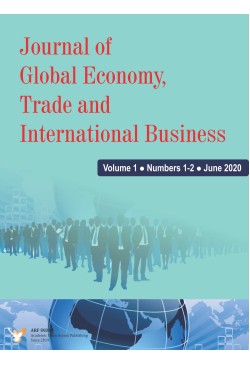
Journal of Global Economy, Trade and International Business
Frequency :Bi-Annual
ISSN :2583-0112
Peer Reviewed Journal
Journal of Global Economy, Trade and International Business (JGETIB) is a double-blind peer-reviewed journal. It is now calling for submissions of original applied and empirical manuscripts in the area of economics, trade and international finance with a global focus. The journal will also consider submissions on current topics in inter-related fields focusing on global economy and/or emerging economies. In addition, the papers related to policy related issues and papers exploring the relationship between emerging and developing economies (individual country or emerging economies as a whole or segment of countries thereof) with developed economies (individual developed country, developed economies as a whole or a segment of countries thereof) will also be considered. This journal seeks quality empirical research while maintaining high ethical standards. The topics may include but not limited to global economic issues, international trade issues, foreign exchange markets, equity markets, foreign investments, exchange rate and its impact on trade, investments, remittances, prices, output and the economy as a whole.
Theme/Focus: The journal will focus on current economic topics with global focus, topics related to international trade and international finances and issues related to the inter-connected areas or inter-connected economies. Applied and empirical papers are welcome for this journal.
GUIDELINES TO THE AUTHORS
Submitted papers should not have been previously published or be currently under consideration for publication in any other journal or book or otherwise. All papers must follow strict ethical guidelines.
Acceptance Rate for the journal is 40% or less
Manuscript Submission: Please submit your manuscript by email (put JGETIB in the subject line) in electronic form using M.S. Word by email to: Dr. Anisul M. Islam, Editor-in-Chief and Professor of Economics, University of Houston-Downtown, Houston, Texas, 77095, U.S.A.; E-mail: islama@uhd.edu
MANUSCRIPT PREPARATION
Page 1: This is the title page of the paper beginning g with the title of the paper on top of the page, bolded and centered, followed by the name(s) of author(s), institutional affiliation, full contact information, corresponding author (* indicate by an * at the end of the corresponding author name), email address(s) and submission date.
Page 2: Repeat the tile of the paper on top of page without any author information (for anonymity) and must have an abstract of no more than 100-200 words followed by a maximum of five keywords, and followed by three JEL Classification codes.
The body of the paper begins immediately after the JEL codes on Page#2. Begin with a section heading such as “Introduction”. Each section headings must be bolded and centered, and sub-headings (if any) in Italics at LHS.
Paragraphs must be indented to avoid ambiguities when a line ends on a full stop and when another paragraph begins. There is no need to have any space between paragraphs.
Figures and Tables should be numbered consecutively and have a self-explanatory short title. Avoid color figures and the use of vertical lines in tables. Any source or notes relevant for these must be added at the bottom.
All equations (expect for very short ones) should be displayed on a separate line. Equations which are cited in the main text should be numbered consecutively on the right margin, using Arabic numerals in parentheses.
End Notes: Footnotes are not allowed, but if any such notes need to be included, then these be placed in a separate section at the end of the paper but before the Reference list using the header “ End Notes”. All end notes must be numbered consecutively using superscript form such as: 1. The authors can provide the data if requested; 2. The data was obtained from primary survey.
References should be listed alphabetically by last name, first name and middle Initial of author(s), followed by Year in parenthesis (see examples below).
Journal Articlers
Srinivasan, V. and Shocker, A. D. (1973), “Linear Programming Techniques for Multidimensional Analysis of Preferences”, Psychometrical, 38 (3), 337-396
Monographs
Elton, E. J. and Gruber, M. J. (1987), Modern Portfolio Theory and Investment Analysis (3nd ed.), John Wiley, New York.
Edited Books: Strunk, Jr., W., White, E.B. (2000), “ The Causes of Pollution” as chapter 2 in Islam and Jha (2020) editors, Modern Theory of Global Warming, fourth ed., Eiley Inc., New York.
Citations: Citations inside the body of the text referring to the article in the Reference list must be done with author name(s) followed by year in parenthesis. For more than one citation, separate one from the other by semi-colon (;). Examples: Islam (2020); Clark and Rubenstein (2016; 2019); for more than three authors: Jha et. al. (2017).
Appendix: Materials such as tables, charts, mathematical derivations etc. that do not need to go inside the text, those can be included in the Appendix section after the reference list.